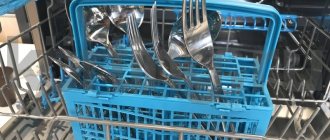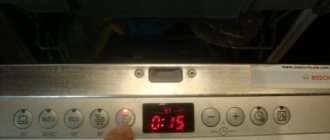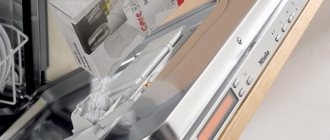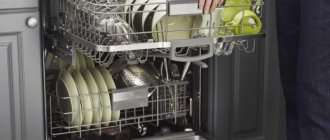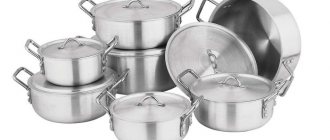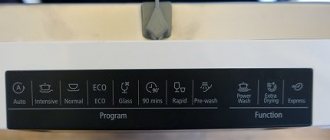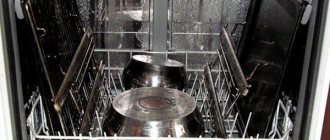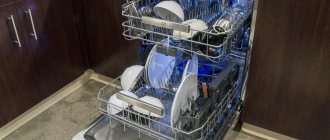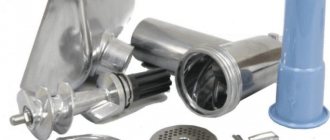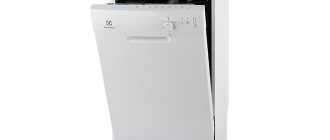Such a modern kitchen appliance as a multicooker brings variety to home meals. A spacious bowl with non-stick coating, an airtight lid, and many installed programs take the cooking process to a new level.
The only difficulty is washing a large container. Worried about the integrity of the bowl's coating, some housewives hesitate to put it in the dishwasher.
- Features of washing a multicooker
- How to properly wash a multicooker?
- Cleaning the bottom
- Expert recommendations
- Catalog of dishwashers with reviews
Features of washing a multicooker
Manufacturers of multicookers make bowls from three types of material:
- aluminum;
- of stainless steel;
- polymetal with ceramic coating.
assortti_ua
dengisegodnya_sko
natalya_olegovna_mikulyak
Aluminum oxidizes at a temperature of 45 degrees. Stainless steel is less susceptible to heat, but over time it also loses its appearance. Ceramic is the most durable option and can withstand up to 10 car wash cycles.
Expert opinion
I work in the household appliance repair industry. Extensive experience in restoring washing machines and dishwashers.
Ask a Question
Therefore, we can say that any bowl does not tolerate cleaning well in the dishwasher. The internal non-stick Teflon coating can quickly lose its useful properties due to high temperatures and abrasive detergents. Violation of the coating, in turn, will lead to sticking and burning of food.
Bowl care
The main removable part of the multicooker is the bowl. This part of the device gets dirty constantly and requires careful maintenance. The method of washing the multicooker bowl depends on the material from which it is made. They are made in one of two possible options:
- made of aluminum;
- made of stainless steel.
Both materials are durable and slightly susceptible to any external influences, so it would seem that there should be no contraindications for washing in the dishwasher. It is worth considering the type of coating of the bowl: it is non-stick, so it is easy to damage the thin layer. High water temperatures and abrasive components in detergents can cause significant damage to the non-stick properties of the bowl. Therefore, it is recommended to wash it manually.
This must be done carefully, based on the type of coating material:
- The Teflon coating can deteriorate when exposed to extreme temperatures, so allow the bowl to cool completely before washing it. Wash only with soft sponges and non-abrasive detergents.
- The ceramic coating is unstable to mechanical impact, so abrasive brushes should be put aside. An anti-grease agent and a soft foam sponge are best suited for treating a dirty bowl and removing food debris and grease.
In addition to the bowl, there are many other parts in the multicooker, so we will consider further how to deal with them in order to keep them clean without titanic efforts.
How to properly wash a multicooker?
Bowl
Regardless of the material used, the multicooker bowl requires careful care, so frequent machine washing is definitely not recommended. Even when handling carefully by hand, remember to only use soft cloths and liquid detergent.
If you are too lazy to wash the bowl with your hands and load it into the dishwasher chamber, select the appropriate delicate mode and pour gel into the compartment. Do not overuse machine washing to extend the life of the bowl.
Lid
Some models of multicookers have a removable lid that can be washed thoroughly under running water. In other cases, it will not be possible to immerse the lid in the sink. Wipe it with a damp cloth and use dishwashing gel to remove grease stains.
Have you set the water hardness in PMM?
Yes, of course. No.
Heating plate
Make sure that this part is always dry and clean. To wash the plate, use a solution of soda and water. When finishing cleaning, be sure to wipe the heater dry.
Steam valve
Another removable element - the steam valve - must be rinsed once a week under running warm water. To wash the mesh, use a grease remover.
Condensate collector
The container for collecting condensate can be easily removed and washed with water. There is no need to use detergent.
How to clean the bottom?
The bottom of the container must be cleaned of grease and food debris formed due to moisture condensation inside the housing. To clean the bottom, use wet wipes. But be sure to remove any solid food particles first—they can cause scratches on the surface.
What is not washed in PMM?
The body of the electrical appliance is wiped with a damp cloth - it is strictly forbidden to immerse it in water or place it in the PMM chamber. When starting to wash the body, turn off the power to the electrical appliance. Clean the multicooker body while wearing microfiber gloves.
Expert recommendations
The cost of purchasing a new bowl will be half the cost of the electrical appliance. Therefore, to avoid unplanned expenses, before loading the container into the dishwasher, read the instructions for the multicooker and find information about the permissibility of machine washing.
Additional metal and plastic accessories of the multicooker can be washed in the dishwasher at a temperature not exceeding 45 degrees.
Before cleaning the housing and non-removable parts, unplug the electrical appliance. Placing it in a sink or dishwasher is strictly prohibited.
Keep your multicooker clean using gentle methods, and it will delight you with tasty and healthy food for a long time.
Everyone should make their own decision about the possibility of washing a bowl in a car, taking into account the circumstances and recommendations of the electrical equipment manufacturer. But it is obvious that cleaning the container manually will preserve the integrity of the non-stick coating longer.
Video
What can be washed in PMM
The manufacturer includes a lot of useful accessories for multicookers and pressure cookers; housewives also buy them separately if necessary. Whether parts can be washed in a dishwasher depends on the materials from which they are made.
- Removable plates and rings: silicone or plastic.
- Steamer: metal or plastic.
- Measuring containers and jars for making homemade yogurt: glass or plastic.
- The deep fryer is usually metal.
- Spatula, ladle or tongs: made of plastic, metal or a combination.
The listed accessories can be safely loaded into the dishwasher hopper. Plastic, metal or glass will not be damaged by water or strong detergents. Silicone parts can also be sent to PMM.
Important! The only accessory that can be cleaned manually from burnt food is the deep fryer: this way you will have a better chance of thoroughly cleaning it from traces of grease.
So, everything that is non-removable and located inside the multicooker is best processed manually, and removable elements, including a steamer, measuring container, spatulas, etc., can be sent to the PMM hopper. As for the bowl, decide for yourself, remembering that the fragile non-stick coating may be damaged, and the price of a new bowl reaches half the cost of a new device.
Find out what other dishes can or cannot be washed in the dishwasher in separate articles.
Cleaning the bowl manually
If the instructions do not allow the use of PMM, the bowl should only be washed by hand. To make all stains disappear faster, simply immerse the container in a bowl of warm water. Do not delay washing; immediately after use, put the bowl in order. Sticky food residues can be easily removed after 15-20 minutes of soaking with a sponge. Grease can be easily removed with dishwashing detergents designed to remove such stains.
Choosing a detergent
It is not recommended to use abrasive substances to care for multicookers, as they can damage the device.
Experts recommend using soft cloths to wash the multicooker.
The multicooker body is the calling card of the device. For most models it is made of plastic. This material must be cared for carefully. It is enough to prepare a soap solution for severe contamination.
It is preferable to use gel detergents.
Is it possible to wash the multicooker bowl in the dishwasher?
By actively using the dishwasher, the housewife expects to wash everything in it. Indeed, if you have already purchased such equipment, then let it work to its fullest, preserving the precious skin of women’s hands. But in life it doesn’t work out that way. Not all items can be put in the dishwasher, because they will simply get spoiled there, and there are plenty of such examples. Today we will figure out whether it is possible to wash the multicooker bowl in the dishwasher. Perhaps these bowls are also on the list of prohibited items, or maybe not, let’s study the issue.
Will it spoil?
There is fierce competition in today's multicooker market. Hundreds of manufacturers offer their products, and consumers are simply wide-eyed. Structural elements of multicookers may differ in materials and technology. Most of the removable parts of any multicooker can withstand contact with the dishwasher, but not the bowl. The fact is that bowls for multicookers are made:
- made of aluminum alloy with a special non-stick coating;
- made of stainless steel with a special non-stick coating;
- made of polymetal or steel with a special ceramic coating.
Any of the bowls should be handled very carefully.
Any of these bowls will suffer after just 1-2 washes and here's why. The non-stick coating partially peels off after the first wash. The exposed aluminum alloy reacts with detergents, turns black and begins to smear with a black coating. A steel bowl behaves much better, but still it becomes unusable because it loses its coating. Ceramics will last the longest, but very soon it will become covered with chips and it will be dangerous to cook, fry or stew something in it. In general, you should not wash ceramics in the dishwasher unless the products have special protection.
As sad as it is to say, any multicooker bowls will have to be washed by hand. Moreover, they need to be washed correctly, otherwise even manual cleaning and washing will quickly ruin them.
How to care properly?
It is better not to leave the bowl unwashed for a long time. After you remove the cooked food, soak the bowl in warm water if you can’t wash it right away. Dried porridge, mashed potatoes, dough are quite difficult to wash off, although the special inner coating of the bowl is designed to make this process as easy as possible.
The bowl should be washed using dishwashing gels and a soft sponge. You can take napkins or soft cloths. Never scrub the inside of the bowl with brushes or sponges with abrasive surfaces. Also, you should not use any cleaning powders or substances containing abrasive particles in general. All this spoils the multicooker pan.
If it turns out that the multicooker bowl is dry, you should not try to scrape off the remaining food. Soak it in hot water for 15-20 minutes, and then use a soft sponge and detergent to wash off all the dirt. After ordinary soaking, the stains will become much more pliable.
Other details
As we studied this topic, we had another question: is it possible to wash other parts from the multicooker in the dishwasher? It turns out that measuring containers, spoons, stands, steamer trays, spatulas, tongs, seals and valves can be washed in the dishwasher, only at a temperature not exceeding 45 0 C. If washed with very hot water, parts made of thin plastic can become deformed, especially measuring containers .
I would especially like to note how well the grease-covered steamer trays are washed in the dishwasher, which, by the way, are “hard work” to wash by hand. The non-removable parts of the multicooker also need to be wiped, as quite a lot of dirt remains on them. Special wet wipes for cleaning are best suited for this. Keep your multicooker clean, and it will definitely reward you with proper operation and deliciously prepared food.
MULTIVARKA.RU – the main site about multicookers
www.multivarka.ru – the main culinary forum about multicookers, recipes, tips, exchange of experience
Multicooker bowl and dishwasher
Multicooker bowl and dishwasher
cornflower » Nov 14, 2009 12:46 pm
Yana » November 14, 2009, 10:59 pm
Advocat » 01 Jan 2010, 14:34
In general, PMMs are very cruel to aluminum. it seems to be the basis of the multicooker bowl
after washing it should corrode and change color - this happens even with fragments of Teflon frying pans (on the handle)
It’s very strange that a modern device is not prepared for washing in a PMM
by railgun » Jan 09, 2010 1:54 pm
Re: Multicooker and dishwasher
by koshenya » Mar 30, 2010 10:17 am
Re: Multicooker and dishwasher
Yana » March 30, 2010, 11:50
Re: Multicooker and dishwasher
Advocat » Mar 30, 2010 12:18 pm
The expert does not go into detail; from the context it is not clear at all whether he has personal experience
I have) - good value for money and quality - somat (Henkel) chews holes in aluminum
Maybe someone has already tried it - please report the results and the name of the detergent
Re: Multicooker and dishwasher
Yana » March 30, 2010, 12:42 pm
Re: Multicooker and dishwasher
by koshenya » Apr 03, 2010, 05:21 pm
Re: Multicooker and dishwasher
Yana » 03 Apr 2010, 18:12
Re: Multicooker and dishwasher
04 Apr 2010, 11:55
Is it possible to wash the MB pan in the dishwasher?
eemitus » Apr 20, 2010 09:25 pm
Re: Is it possible to wash the MV pan in the dishwasher?
Yana » Apr 20, 2010, 09:59 pm
Re: Is it possible to wash the MV pan in the dishwasher?
eemitus » Apr 20, 2010 10:52 pm
Re: Is it possible to wash the MV pan in the dishwasher?
Andyvit » April 21, 2010, 09:02 pm
Can the multicooker be washed in the dishwasher?
Many housewives have already acquired multicookers - a kitchen appliance that simplifies the process of cooking to the maximum. The food in it cooks itself - in automatic mode. But, as always, you have to pay for convenience - the multicooker needs to be washed. And if the process of washing dishes in your kitchen is automated, then the question naturally arises: is it possible to wash a multicooker in a dishwasher (DMM)?
Features of washing a multicooker
A multicooker is an electrical appliance that cannot easily be put under water. Even the means for washing it must be selected with care:
- It is prohibited to clean the device with pastes and powders containing abrasive particles.
- Sponges and napkins used for hand washing must be soft - hard objects can damage the surfaces of the multicooker parts.
- Do not use solvents to clean the housing. You need to wash the surface with warm water with the addition of dish gel.
All parts of the electrical appliance are washed separately - they require an individual approach. You cannot wash the entire appliance in the dishwasher - only its individual parts. The newfangled automatic cooking device consists of:
- bowls;
- covers;
- steam valves;
- heater plates;
- moisture collector.
How to wash a multicooker?
It is easy to understand that this electrical appliance should be washed in parts. Moreover, some parts can be washed in a PMM, while all others can be washed manually.
It is especially tempting to wash the bowl, the largest removable part of the “electric saucepan,” in the dishwasher. It is this that is exposed to contamination during use, so it must be washed frequently and thoroughly.
Important! When deciding how to wash the removable multicooker bowl, you need to find out what material it is made of.
Based on the material used to make the bowl, there are:
- Aluminum. There is a special coating inside the aluminum bowl.
- Made from stainless steel. It is made in the form of a fully cast part.
The bowl is made of durable materials that are resistant to any type of impact. But they have a weak spot - the non-stick layer. The coating is extremely thin, it is very easy to damage, it is especially susceptible to:
- mechanical abrasive effects;
- hot water.
When washing a bowl, you need to consider the type of coating:
- Teflon. Danger - destruction due to temperature changes. Before you begin delicate washing, the container must be cooled.
- Ceramic. Afraid of mechanical impact. Do not use abrasive brushes.
Important! If the bowl cover is damaged due to abuse and the appliance can still operate, replace the damaged part. Many manufacturers supply bowls as “consumables”.
If you are too lazy to wash the bowl by hand, take care to choose the appropriate dishwasher mode. This part needs the most delicate washing.
Lid
Grease stains are washed off using cloth napkins. To thoroughly clean the lid, you can use the usual product you use to wash kitchen utensils.
Heating plate
This part must be kept in special conditions - the plate must be clean and dry. If the heating element is dirty, dissolve soda in water. Wet the sponge with soda solution and wipe away any dirt. Finally, wipe the plate with dry wipes.
Steam valve
This part is also removable. To keep the valve clean, simply rinse it. Use warm water for washing. This procedure is performed weekly. To clean the mesh, use a product that breaks down fats.
